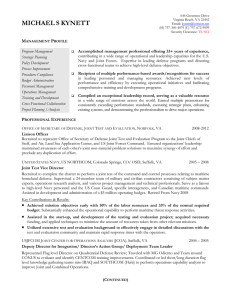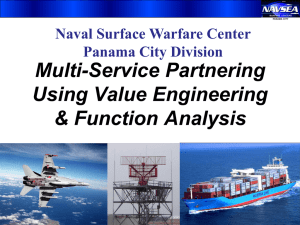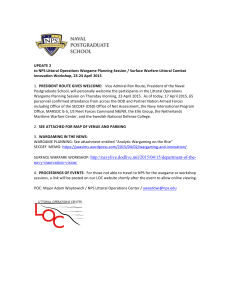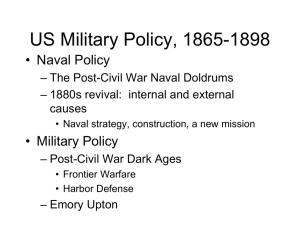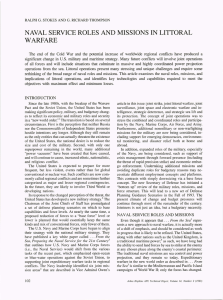GUEST EDITOR'S INTRODUCTION NAVAL TECHNOLOGIES IN THE LITTORAL BATTLESPACE _
advertisement
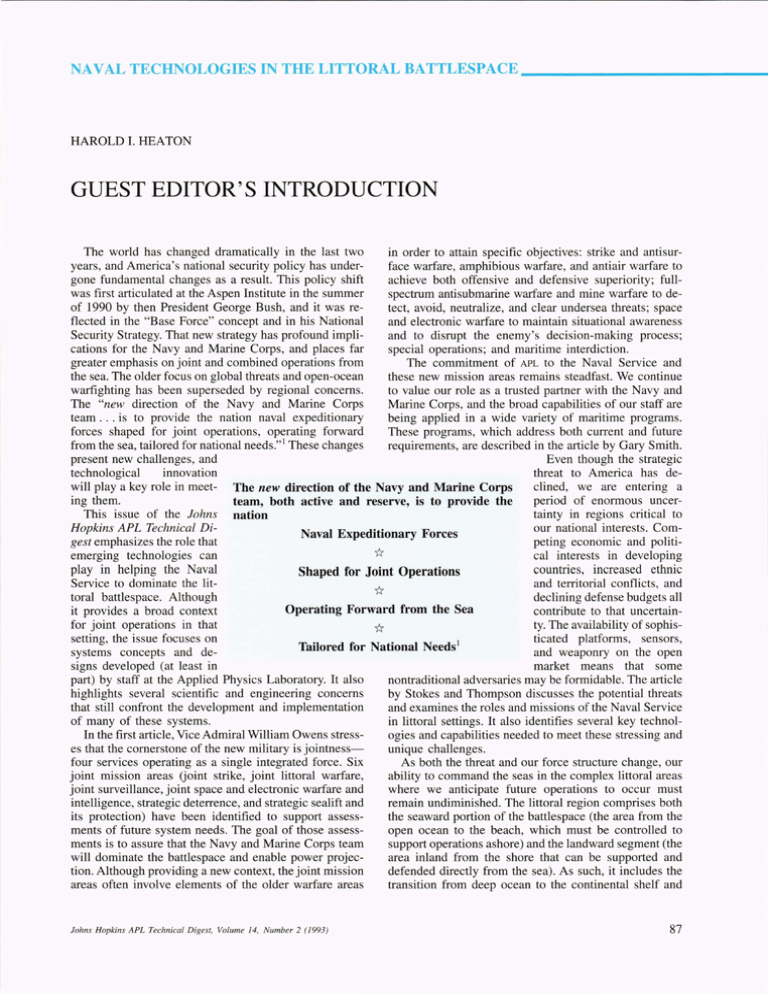
NAVAL TECHNOLOGIES IN THE LITTORAL BATTLESPACE _ _ _ _ _ _ _ _ _ _ __ HAROLD I. HEATON GUEST EDITOR'S INTRODUCTION The world has changed dramatically in the last two in order to attain specifIc objectives: strike and anti suryears, and America's national security policy has underface warfare, amphibious warfare, and anti air warfare to gone fundamental changes as a result. This policy shift achieve both offensive and defensive superiority; fullwas fIrst articulated at the Aspen Institute in the summer spectrum antisubmarine warfare and mine warfare to deof 1990 by then President George Bush, and it was retect, avoid, neutralize, and clear undersea threats; space flected in the "Base Force" concept and in his National and electronic warfare to maintain situational awareness Security Strategy. That new strategy has profound impliand to disrupt the enemy's decision-making process; cations for the Navy and Marine Corps, and places far special operations; and maritime interdiction. greater emphasis on joint and combined operations from The commitment of APL to the Naval Service and the sea. The older focus on global threats and open-ocean these new mission areas remains steadfast. We continue warfIghting has been superseded by regional concerns. to value our role as a trusted partner with the Navy and The "new direction of the Navy and Marine Corps Marine Corps, and the broad capabilities of our staff are team ... is to provide the nation naval expeditionary being applied in a wide variety of maritime programs. These programs, which address both current and future forces shaped for joint operations, operating forward from the sea, tailored for national needs." 1 These changes requirements, are described in the article by Gary Smith. present new challenges, and Even though the strategic threat to America has detechnological innovation clined, we are entering a will playa key role in meet- The new direction of the Navy and Marine Corps period of enormous uncering them. team, both active and reserve, is to provide the tainty in regions critical to This issue of the fohns nation Hopkins APL Technical Diour national interests. ComNaval Expeditionary Forces gest emphasizes the role that peting economic and politiemerging technologies can cal interests in developing play in helping the Naval countries, increased ethnic Shaped for Joint Operations Service to dominate the litand territorial conflicts, and toral battles pace. Although declining defense budgets all Operating Forward from the Sea it provides a broad context contribute to that uncertainfor joint operations in that ty. The availability of sophisticated platforms, sensors, setting, the issue focuses on Tailored for National Needs l and weaponry on the open systems concepts and demarket means that some signs developed (at least in part) by staff at the Applied Physics Laboratory. It also nontraditional adversaries may be formidable. The article highlights several scientifIc and engineering concerns by Stokes and Thompson discusses the potential threats that still confront the development and implementation and examines the roles and missions of the Naval Service of many of these systems. in littoral settings. It also identifIes several key technolIn the fIrst article, Vice Admiral William Owens stressogies and capabilities needed to meet these stressing and es that the cornerstone of the new military is jointnessunique challenges. four services operating as a single integrated force. Six As both the threat and our force structure change, our joint mission areas (joint strike, joint littoral warfare, ability to command the seas in the complex littoral areas joint surveillance, joint space and electronic warfare and where we anticipate future operations to occur must intelligence, strategic deterrence, and strategic sealift and remain undiminished. The littoral region comprises both the seaward portion of the battlespace (the area from the its protection) have been identifIed to support assessments of future system needs. The goal of those assessopen ocean to the beach, which must be controlled to ments is to assure that the Navy and Marine Corps team support operations ashore) and the landward segment (the will dominate the battlespace and enable power projecarea inland from the shore that can be supported and tion. Although providing a new context, the joint mission defended directly from the sea). As such, it includes the areas often involve elements of the older warfare areas transition from deep ocean to the continental shelf and * * * Johns Hopkins APL Technical Digest, Volume 14, Number 2 (1993) 87 H. 1. Heaton from the beach to land, and thus presents a wide variety of operational settings. This situation places substantial demands on the weapons and sensors that must support our forces' objectives. Sinex and Winokur provide an overview of the complex environmental interactions in this zone and discuss their potential impact on amphibious operations. They also describe several new methods that are being developed for measuring and predicting environmental features associated with important processes in littoral regions. The warm water temperatures, high humidity, complex hydrodynamic and chemical backgrounds, and high water opacity in addition to high reverberation and noise levels, and the proximity of the bottom may constrain the performance of a variety of acoustic and nonacoustic sensors in these settings. The littoral regions where conflicts may arise will often be unfamiliar territory to our forces, and may be easily mined by an aggressor. The airspace may be occupied by allies, adversaries, and neutral parties. The fleet is also likely to encounter highly capable antiship missile threats that employ the latest sea-skimming weapons technology. This latter concern has led APL to support the Navy in developing a Ship Self-Defense "Road-Map," which provides a technical approach for (1) achieving the capability needed to counter the antiair threat through incremental system improvements, (2) developing critically needed new system components, and (3) integrating them into ship combat systems. This mapping serves as the basis for several current design and development activities, described further in the article by Ousborne. The threat of also encountering tactical ballistic missiles in littoral settings, dramatically evident during Desert Storm, has revitalized our national program for theater missile defense. A critical element of this new defensive capability will be the sea-based component. An early capability may be implemented initially over a limited area by a modified Standard missile and by associated changes to the Aegis combat system. In their article, Rempt and Langston describe this option and the technologies and system concepts under consideration for future implementation of a longer-range naval component to the theater ballistic missile defense system. Future systems might cooperatively engage threats by sharing targeting information among platforms, and good target cueing and various levels of data fusion may be necessary. The Naval Service will have fewer ships and personnel in the future , but it will face a more diverse threat. Although the Navy will take delivery of several new ships by the end of 1994, these were "born" in the era of the Cold War and they may not fully meet the needs of a littoral expeditionary force. Unmanned underwater vehicles (UUy'S) might enable force planners to extend the command, control, and surveillance functions of these and other ships in an affordable manner. The article by Shotts and McNamara identifies several potential roles for unmanned underwater vehicles (e.g., mine detection and surveillance), discusses critical technology areas that must continue to be developed to implement those roles, and recommends an investment strategy in support of the Navy's mission to project power from the sea. Systems 88 to support the roles are achievable through the application of current or near-term technology. Battlespace surveillance from overhead sensors and UUy'S develops essential management and targeting information for strike and amphibious assault platforms, but extended underseas surveillance is also essential to protect the surface and submarine forces. The acoustic sensors that traditionally provide these surveillance data have been developed primarily for use in deep-water regions and may suffer reduced performance in shelf environments. In their article, Lombardo, Newhall, and Feuillet describe the development and testing of two new mobile arrays of hydrophones that address the changing requirements for submarine surveillance in both deep-ocean and littoral settings. Very high gain has been achieved at very low frequencies in noisy environments seaward of the shelf. The higher-frequency twin-line array (capable of resolving the persistent "bearing ambiguity" problem) promises good performance in shallow waters even in the presence of dense shipping. Although each such array is populated with conventional hydrophones connected by wires, rapid advances in photonics technology may result in all-optical towed arrays in the future. Acoustic propagation can be highly variable in shallow water because of the spatial variability of bottom conditions and multiple acoustic interactions with the interfaces. In some situations, propagation ranges may be limited, and distributed low-gain acoustic sensors may be more appropriate than high-gain acoustic arrays. In order to choose optimal designs for future shallow-water systems, reliable acoustic propagation models are required. Boyles and Biondo discuss the physical factors that must be taken into account to accurately model shallow-water acoustic propagation. They also survey the generic classes of acoustic models available to assess how well each takes the identified factors into account. Given the difficulty of detecting targets in littoral areas, no one sensor will provide an adequate view of the tactical scene. New techniques for communicating and properly fusing data from the undersea and above-sea scenes will be needed. The article by Widmer describes a promising approach to the former, a highly reliable but oneway communications channel based on low-frequency active acoustics. This low-data-rate system has been implemented during testing at sea, and its utility has been demonstrated. The large volume of composite battles pace information that may be rapidly presented to system operators emphasizes the need for effective information management and command-level decision aids on each platform, to ensure that our forces maintain a tactical advantage. Dantzler and Scheerer address this need in the final paper of this issue by exploring the suitability of using expert systems technology for autonomously describing and continually refining the undersea oceanographic scene. Advanced simulations of the composite performance of real and simulated units operating in a virtual battlespace may play a role in evaluating the efficacy of such a capability. Large-scale simulations also promise to provide a cost-effective approach for training warfighters, Johns Hopkins APL Technical Digest, Volume 14, Number 2 (1993) Guest Editor 's Introduction evaluating tactics, and developing competitive investment strategies that can help preserve our national interests in the future. Technological innovation is vital both to the success of the littoral systems and to the new joint mission areas. In his December 1991 foreign policy speech entitled "A New Covenant for American Security," (then presidential candidate) Bill Clinton described four generic categories of military competence as essential for a restructured military. Among them was the need to maintain our technological edge. This theme was echoed by (then Representative) Les Aspin in a 1992 speech before the Jewish Institute for National Security Affairs, where he said that "as far as technology goes, we are living in a different world . .. In World War II, if we wanted to have a ninety percent chance of knocking out a medium-sized target, we had to plan to drop 9,000 bombs on it. In Vietnam, the figure was about 175 bombs. In Operation Desert Storm, we are talking about numbers in the single digits." Technology leverages the response options available to military strategists, and may compel an adversary to avoid further escalation in limited conflicts. As the defense establishment declines, and new approaches to defense management evolve, the threat will continue to proliferate. In this climate, technology is a key force-multiplier. The technology thrust areas (global surveillance and communications, precision strike, air defense and superiority, undersea superiority, training and readiness, and reducing acquisition time and cost) defined recently by then Director of Defense Research and Engineering Victor Reis remain as relevant to the Navy today as in the past. But many of the companies that sustained themselves by developing defense technologies (partly to meet these thrusts) must now diversify their business and form teaming arrangements in order to remain solvent. The management policies that evolve to implement President Clinton's Defense Reinvestment and Conversion Initiative (as outlined in his March 1993 presentation at Westinghouse, Linthicum, Md.) will leverage our past investment in defense technology to Johns Hopkins APL Technical Digest, Volume 14, Number 2 (1993) benefit the civilian sector-but they must also ensure the continued application of advanced technology to our defense needs. Only the focus has changed to emphasize joint military operations in-theater, and a dual-use industrial capacity at home. REFERENCE ' ... From the Sea, Preparing the Na val Service / or the 21 st Century, Marine Corps White Paper, p. 3 (Sep 1992). avy and THE AUTHOR DR. HAROLD 1. HEATON is the Programs Manager and a Principal Staff physicist in the Submarine Technology Department. He joined APL in 1977 as an evaluator of industrial concepts for nonacoustic antisubmarine warfare sensors, and became manager of the remote sensing elements of the SSBN Security Program at the Laboratory in 1981. He was appointed as the manager of all remote sensing programs in the Submarine Technology Department in 1984 and assumed his present position as the Programs Manager in 1988. He served as Program Chairman of the Second Submarine Technology Symposium held at APL in 1989. Before joining APL, Dr. Heaton was a Senior Scientist with EG&G, Inc., in Los Alamos, . M. , where he analyzed nuclear burst imagery and spectra. Dr. Heaton was educated at the University of Massachusetts, Amherst, where he was awarded Ph.D. and M. S. degrees in astrophysics in 1974 and 1970, respectively, and a B. A. degree in astronomy in 1968. He is a member of the Optical Society of America, the IEEE Lasers and Electrooptics Society, and the American Astronomical Society. 89
